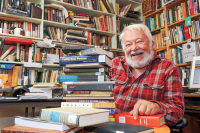Indie film brings big economic boost: From stunt pilots to bar scenes, movie producer weaves local people and places into script
Western North Carolina has seen its share of Hollywood productions. But unlike many of the other movies filmed here, “Road to Nowhere” features a story that is actually set in the area.
Very little had to be changed for the sake of filming, whether it was “Waynesville Police” emblazoned on cop cars that peel through one scene or the historic environs of the Balsam Mountain Inn.
“This is not North Carolina doubling for something else,” said Steven Gaydos, co-writer and producer for the film. “This is a story set in North Carolina.”
Gaydos joked that scenic backdrops here are so plentiful they could put up their fingers and frame a shot any direction they looked.
The movie began shooting in the area in early July and wrapped up in North Carolina this week. The filmmakers have shot scenes at Fontana Dam, Balsam Mountain Inn, Boyd Mountain Log Cabins in Waynesville, Doc Holliday’s bar in Maggie Valley, and the Jackson County airport in Sylva.
“Road to Nowhere” is working with a budget of under $5 million, all of which was raised privately. According to Gaydos, the rough plan is to submit it to a festival like the Sundance Film Festival or the Cannes Film Festival early next year. He hopes that the independent movie will be bought and released by fall 2010.
Economic boost
When a movie shooting comes to town, it brings with it more than just Hollywood glamour. “Road to Nowhere” has provided tangible benefits for local hires and businesses alike during its time here.
The cast and crew occupied 34 out of 50 rooms at Balsam Mountain Inn for four to five weeks. The inn also served them breakfast, lunch, and dinner for much of that time.
While tourists usually flock to the inn during the summer, the recession has certainly created a bit of a downturn in business.
“July is one of our busier months. This year has been a little slower,” said Marla Brown, front desk manager for the inn.
But housing and feeding the cast and crew for more than a month has made a “very positive impact” on business, said Innkeeper Sharon Shailer.
Jim Rowell, a Cullowhee resident, struck a deal with the moviemakers that allowed him to make a fuel pump repair at the airport in exchange for flying his plane as a stuntman in the movie. Rowell said the repair would probably have cost a few hundred dollars, something the cash-strapped airport couldn’t afford.
In Haywood County, Boyd Mountain Log Cabins was compensated for permitting filmmakers to shoot several scenes there for two days.
Movie co-writer and producer Gaydos said they have bought gallons and gallons of paint, among other materials, from local building supply stores to construct their sets.
And it’s not just businesses that profit from moviemakers coming to the area. Ella Kliger, a Franklin woman who serves as the movie’s production assistant coordinator, estimated that about 40 percent of “Road to Nowhere” crew members were North Carolinians.
Kliger, an independent documentary filmmaker who moved to the area from Mississippi in May, said she was surprised to see a call for crew members so close to her new hometown.
“I expected to have to go to Atlanta to get this kind of work,” said Kliger.
Several area students worked as production assistants in the film, including North Carolina School of Arts and Film sophomores Nick Fanego of Canton and Quentin Noms of Sylva, as well as Mandy Hughes, an Asheville native who attends Western Carolina University.
While the students say they appreciate the firsthand experience and learning opportunities with some “extremely friendly” staff, they acknowledge the need to keep cool.
“It would be really unprofessional to go up and ask, ‘Can you sign this?’” said Noms.
“This is a job. They’re not just here to welcome us,” said Hughes. “They expect us to get to work.”
And what does that work actually involve?
“Anything and everything,” according to Hughes, who has helped with make-up and wardrobe, rounding up actors, ensuring there’s quiet on the set, and even first aid for an actor who accidentally got a cut on his neck.
Production assistants are often used as extras in the film. Hughes said a make-up girl once grabbed her without warning, put down her hair and immediately began preparing her for a scene.
“You don’t know what to expect,” said Fanego.
Setting the scene
Despite a key scene that involves a dramatic plane crash into Fontana Dam, pilot Jim Rowell reassures us that no airplanes were killed in the making of the film. As the stuntman who flew the plane near the dam, he would know.
Rowell did eight or nine passes over the lake, flying as low as 300 to 500 feet above the water’s surface and turning a few times. With almost 20 years of experience flying his 1966 Piper Cherokee four-passenger plane, Rowell said he wasn’t nervous about doing the moves, but he admits it was a bit unnerving flying for the cameras.
“I was doing a lot of sweating in the plane to be right where they wanted me to be when they wanted me to be,” said Rowell.
Rowell also worked as a kind of airport coordinator, moving planes as needed by the filmmakers. Video editors will cut back and forth between shots of Rowell flying the plane near the dam and the actual actor sitting in Rowell’s plane pretending to fly while in front of a green screen backdrop at the airport hangar.
“We’ll use the magic of Hollywood,” said Gaydos, adding that Tennessee Valley Authority probably wouldn’t like them to crash a plane into the dam.
Shooting at the Boyd Mountain Log Cabins did take a little preparation. Crew members covered the floor with linoleum and used styrofoam boards to protect furniture while filming.
Owner Betsy Boyd said she was impressed with the neat and precise way in which the crew operated.
“It was just fun to see so much activity,” Boyd said. “Our cabin renters here were welcome to come in and watch the filming.”
Shailer, innkeeper at Balsam Mountain Inn, said her biggest concern about the shooting had been that it would be a distraction from what guests normally expect: peace and relaxation. But Shailer said her guests also lingered to watch.
“They thought it was neat,” she said.
There were some inconveniences during the shooting of “Road to Nowhere,” including housekeepers not being able to get to certain rooms to clean them or quiet hours not always being strictly observed with all the hubbub of cast and crew. But Boyd and Shailer had only positive things to say about their experience.
The two businesses have been no strangers to productions in the past. “In the Shadow of Cold Mountain” was shot at Boyd Mountain Log Cabins, while Balsam Mountain Inn once hosted an episode of the Travel Channel show “Weird Travels,” which focused on haunted hotels.
Boyd and Shailer say they are in favor of more filmmakers coming to western North Carolina.
“Not just for the local economy, but so that people get a better flavor of [the area],” said Shailer.
Gaydos admits that Hollywood tends to treat the America “outside of New York and Los Angeles” with a bit of condescension.
“Monte [the director] and I are almost religiously against that,” said Gaydos, who assures the public that “Road to Nowhere” will avoid such an attitude.
“This is Hollywood meets North Carolina, but it’s not like people in Hollywood are sharp and smart and all the people in North Carolina are naïve. It’s maybe the opposite,” Gaydos said.
Moreover, Gaydos said anyone will be hard-pressed to find even one cast or crew member who hasn’t “completely fallen in love” with the area.
“I mean, how could you not?” Gaydos added.
Battle for film makers
One might think it a no-brainer that a movie taking place in North Carolina would be shot in North Carolina. As evidenced by “Cold Mountain,” filmed in Romania, that isn’t necessarily the case.
“When an executive decides where the movie will be...it’s a financial decision,” said Aaron Syrett, film commissioner for the state.
Tax incentives have played a vital role in whether filmmakers come here, or go to places like Michigan, where a tax credit of a whopping 42 percent of their in-state expenditures is offered. Georgia hands out a 30 percent tax credit, while North Carolina offers half that.
In North Carolina, a motion picture must spend a minimum of $250,000 to qualify for a tax rebate. The state will then perform an audit, after which it will provide a tax credit of 15 percent on goods, services, and wages taxed by North Carolina.
Syrett said North Carolina had always been a destination for Hollywood until Canada launched aggressive financial incentives that “killed U.S. film industries.”
Louisiana reacted to that in 2003 with its own film incentive: a 25 percent tax credit. New Mexico followed along with other states after them. North Carolina was a bit late but got back into the game in 2006 with a newly-instituted tax credit.
While North Carolina doesn’t offer as much as other states, the plethora of studios and convenient infrastructure combined with the incentive makes film production here “very, very viable,” said Syrett.
According to him, motion pictures spent a little under $99 million in North Carolina in 2006. After the rebate was instituted, that number jumped 67 percent in 2007 to $161 million. With increasing competition from other states with higher tax incentives, spending decreased to $95 million by 2008.
Now, the N.C. Senate recently passed a bill to increase the state’s incentive to 25 percent. It is now awaiting approval in the House of Representatives.
While a battle of ever increasing tax incentives among states seems to loom ahead, Syrett said there has to be a limit.
“There’s a point where we have to stop, and we believe that 25 percent is a benchmark,” said Syrett. “We have to be fiscally sound. We’re not in an arms race.”
Even when one leaves competition among states aside, there’s still competition within states.
“When producers think of filmmaking in North Carolina, they think of Wilmington,” Rowell remarked. “They have studios down there, but there’s a lot of good potential out this way, too.”
So with all these options, how did Gaydos and his film wind up in Western North Carolina?
“The wonders of Google,” Gaydos said. Gaydos had his heart set on a scene with a plane crash into a dam. He typed in a search for “dam,” “lake,” and “mountains,” and there it was: Fontana Dam.
Intrigue and mystery drive movie’s story line
Despite its title, a movie being shot in WNC called “Road to Nowhere” has nothing to do with the local political controversy of the same name. Forget the heated dispute over constructing the North Shore Road in Swain County — this film is about a movie director entranced by a financial scandal that results in a double suicide and a murdered cop.
The movie director stumbles upon a journalist’s report of a true crime story involving a businessman in Western North Carolina. The businessman was caught in a financial scandal, and as his world unravels he flies his private plane into Fontana Dam to commit suicide. Meanwhile, his girlfriend and assistant drives her car over a cliff.
The director travels from California to North Carolina to shoot a film based on the crime story. But as the director delves into the story, he unearths some mysterious twists.
“ [The director] starts to discover that nothing in this true story is true,” said Steven Gaydos, co-writer and producer for the film. Thus, the title of this film about a film serves as a metaphor for the plot.





